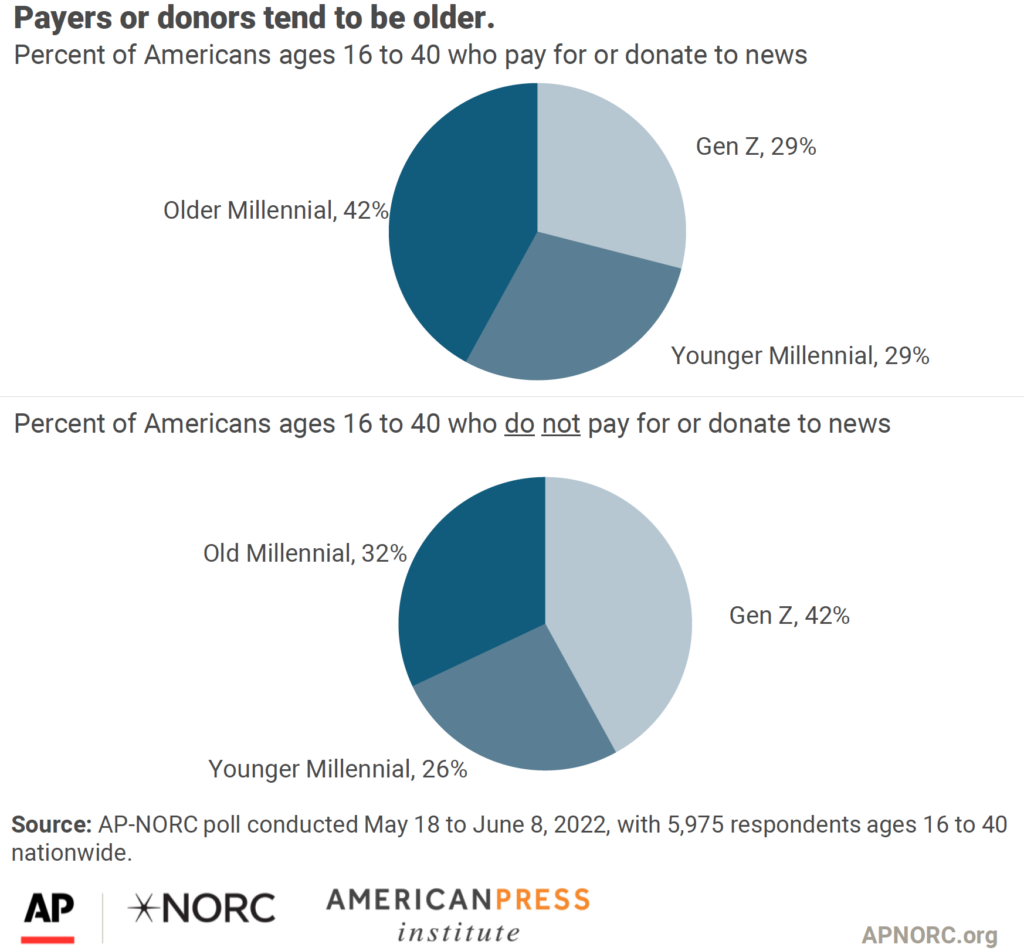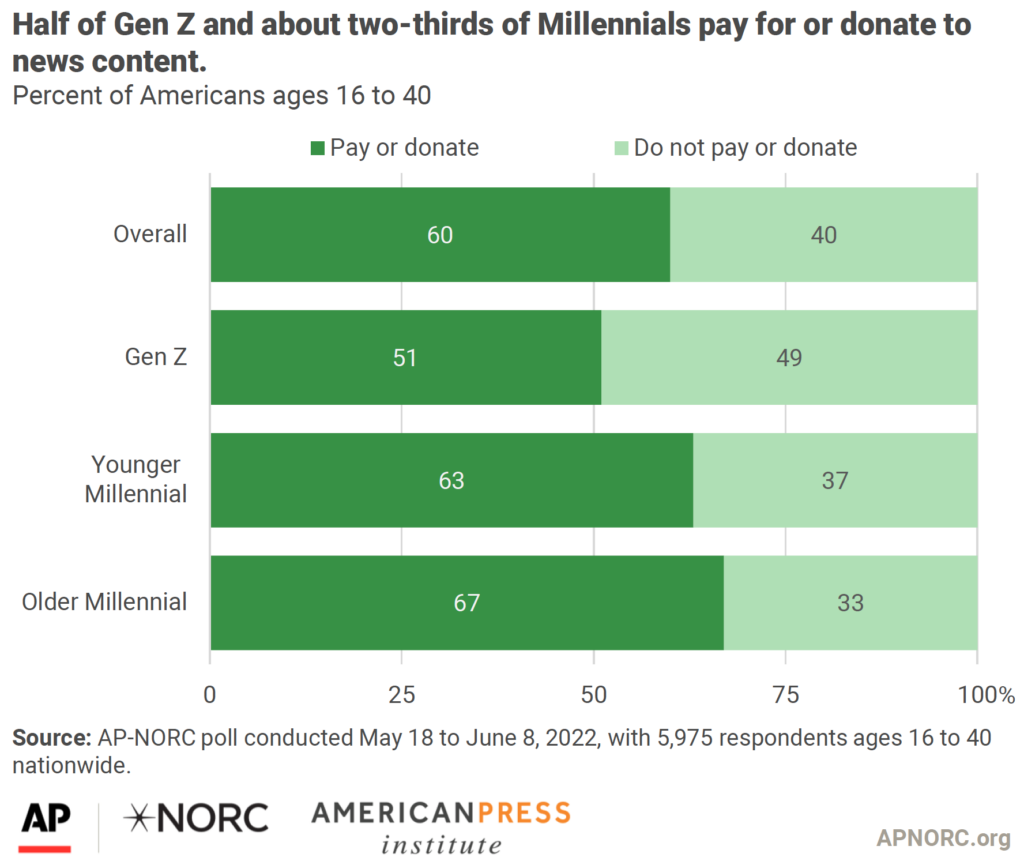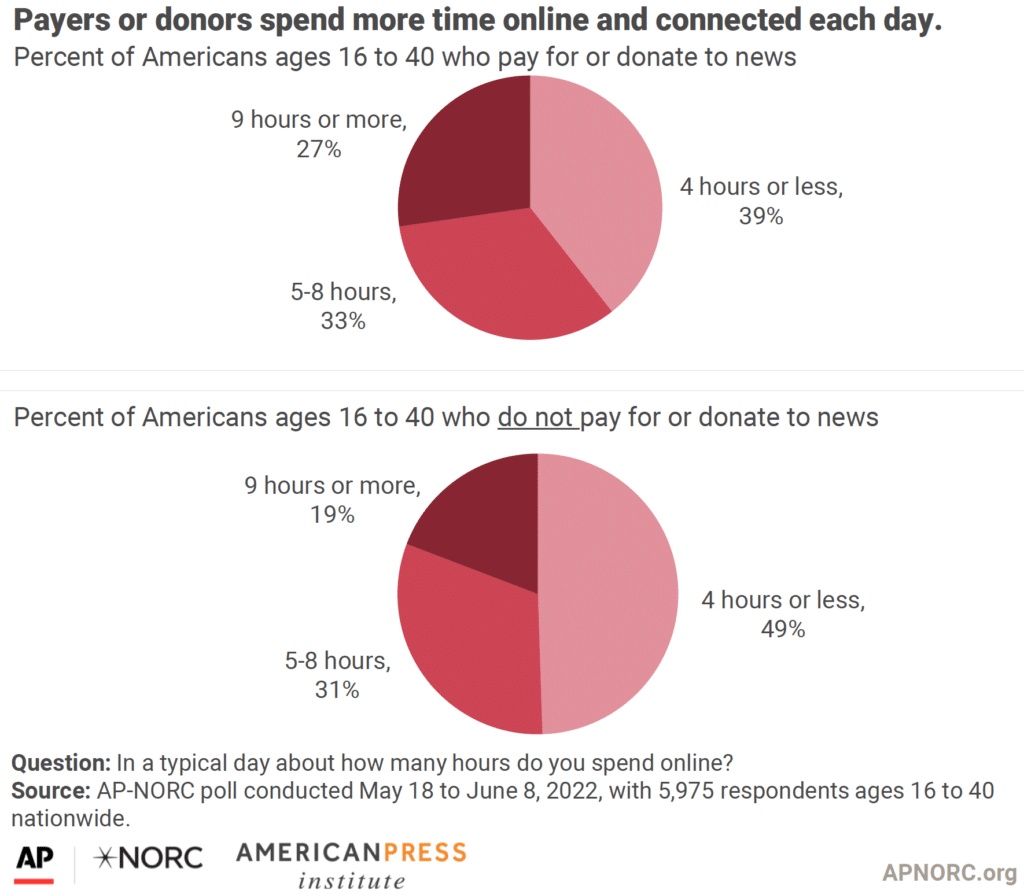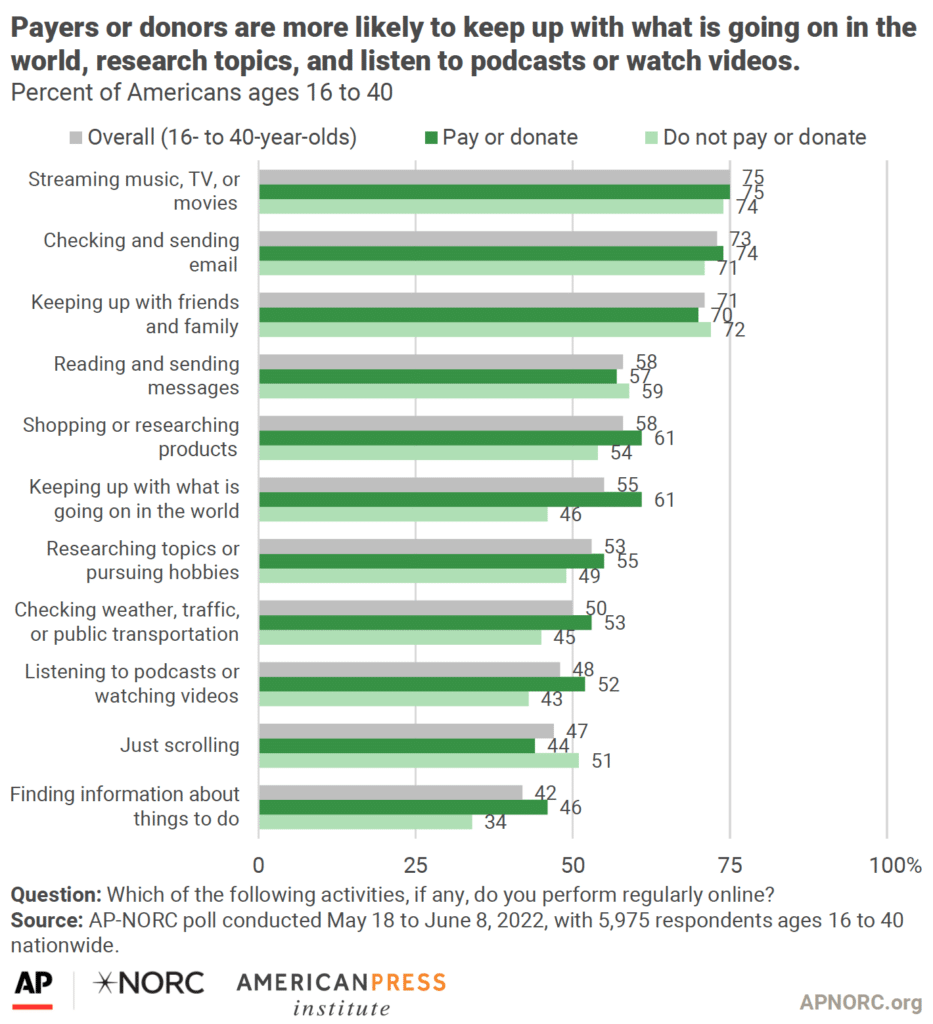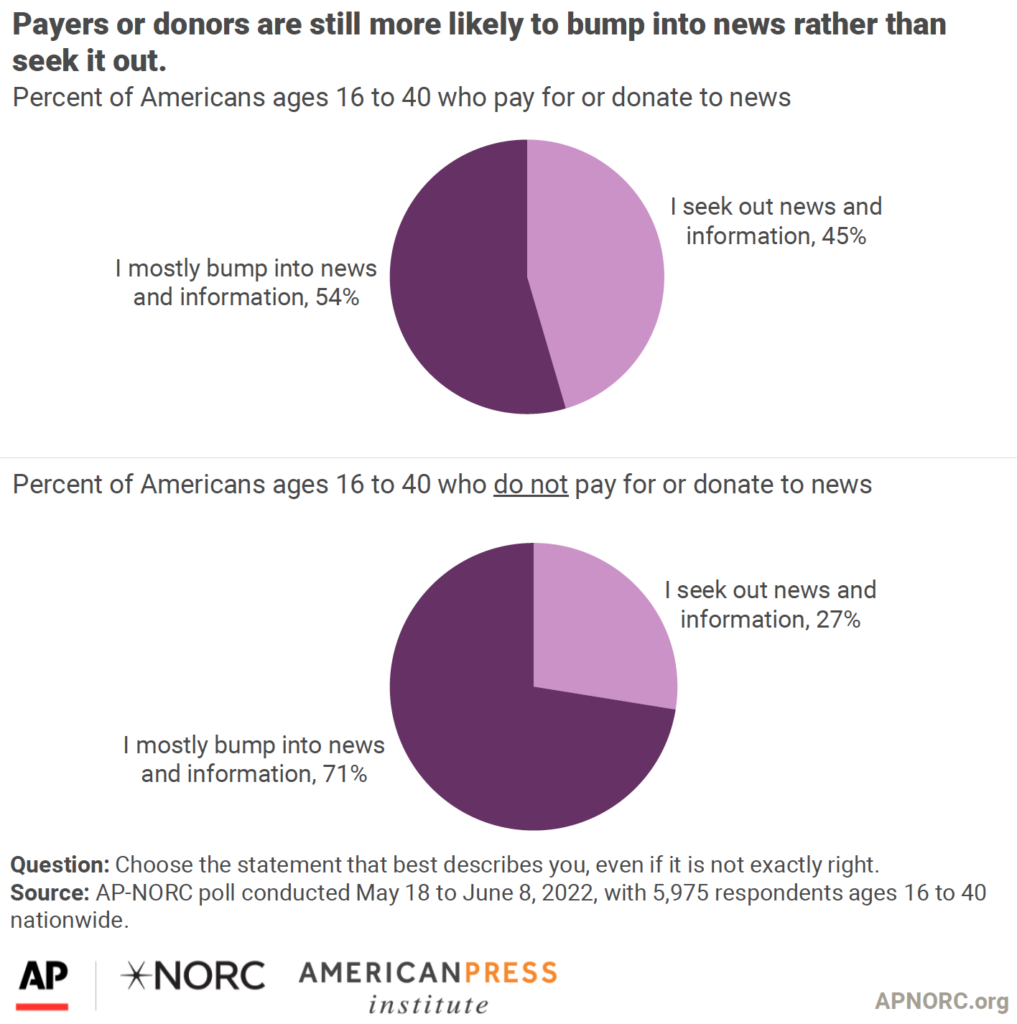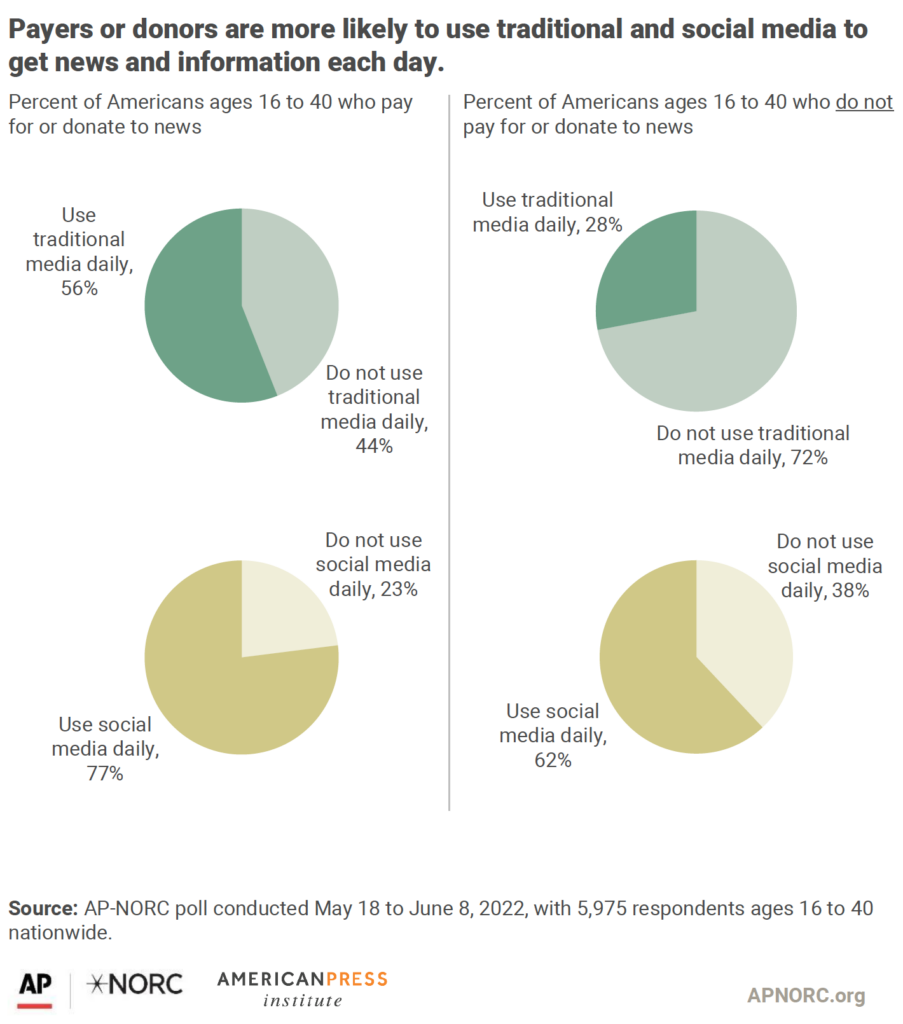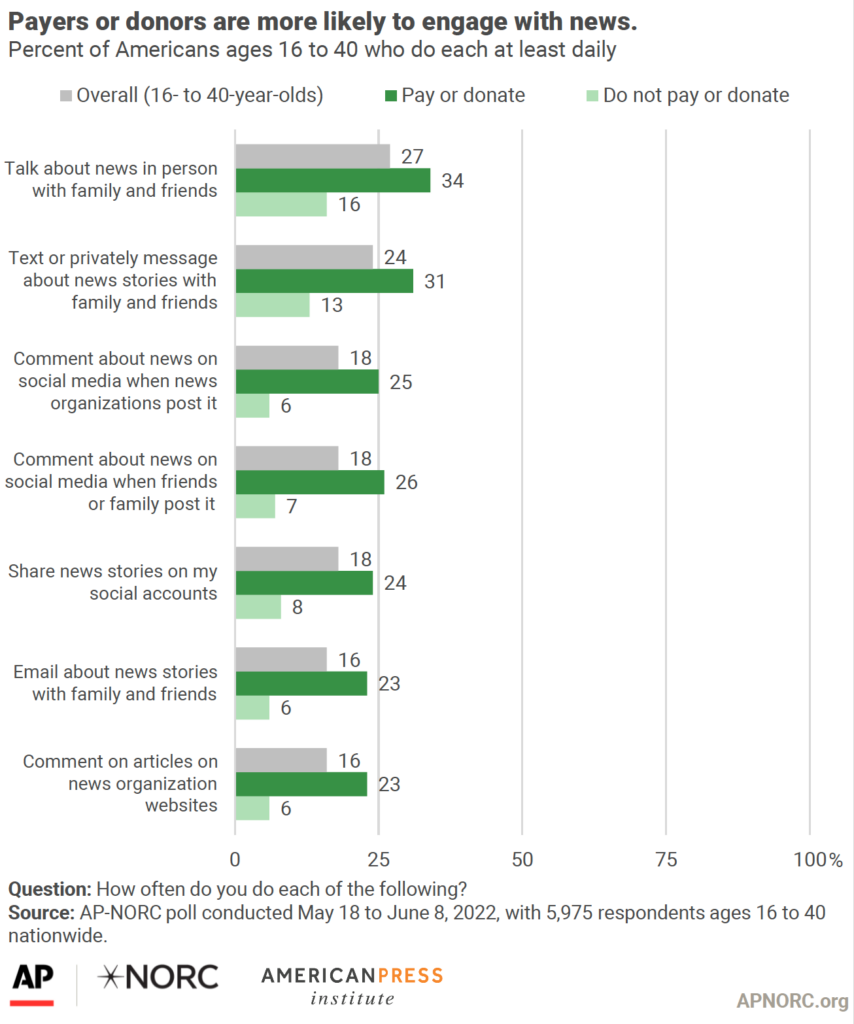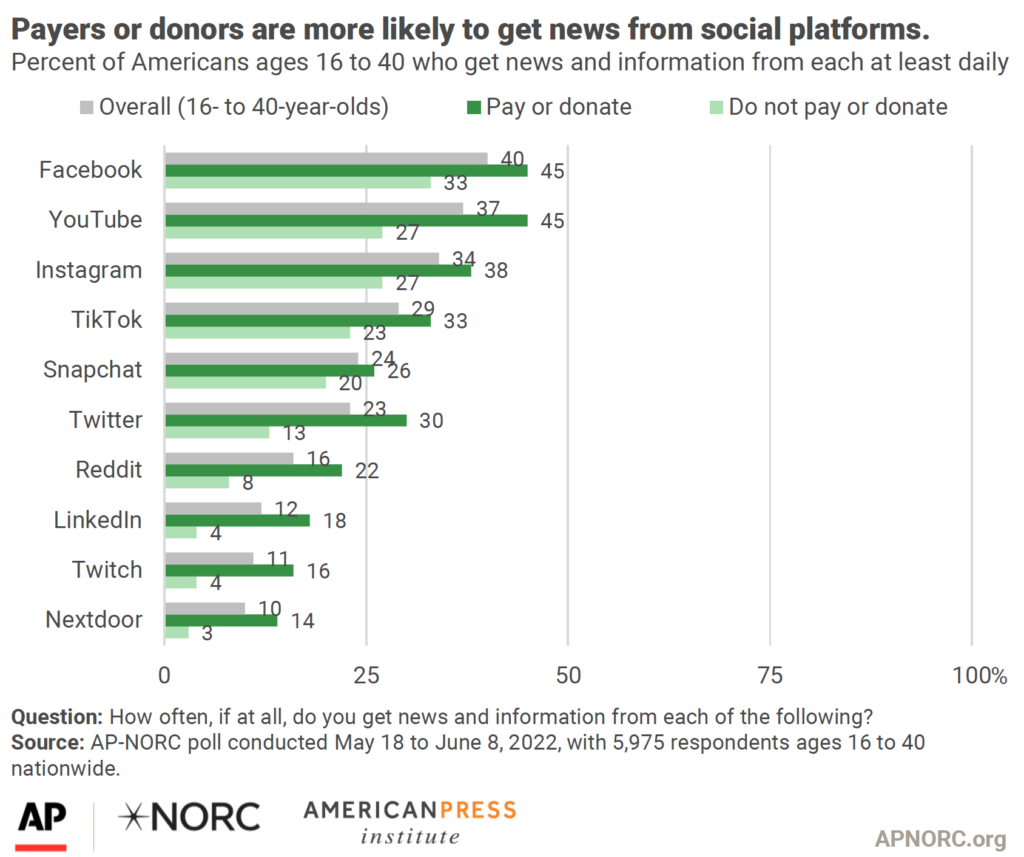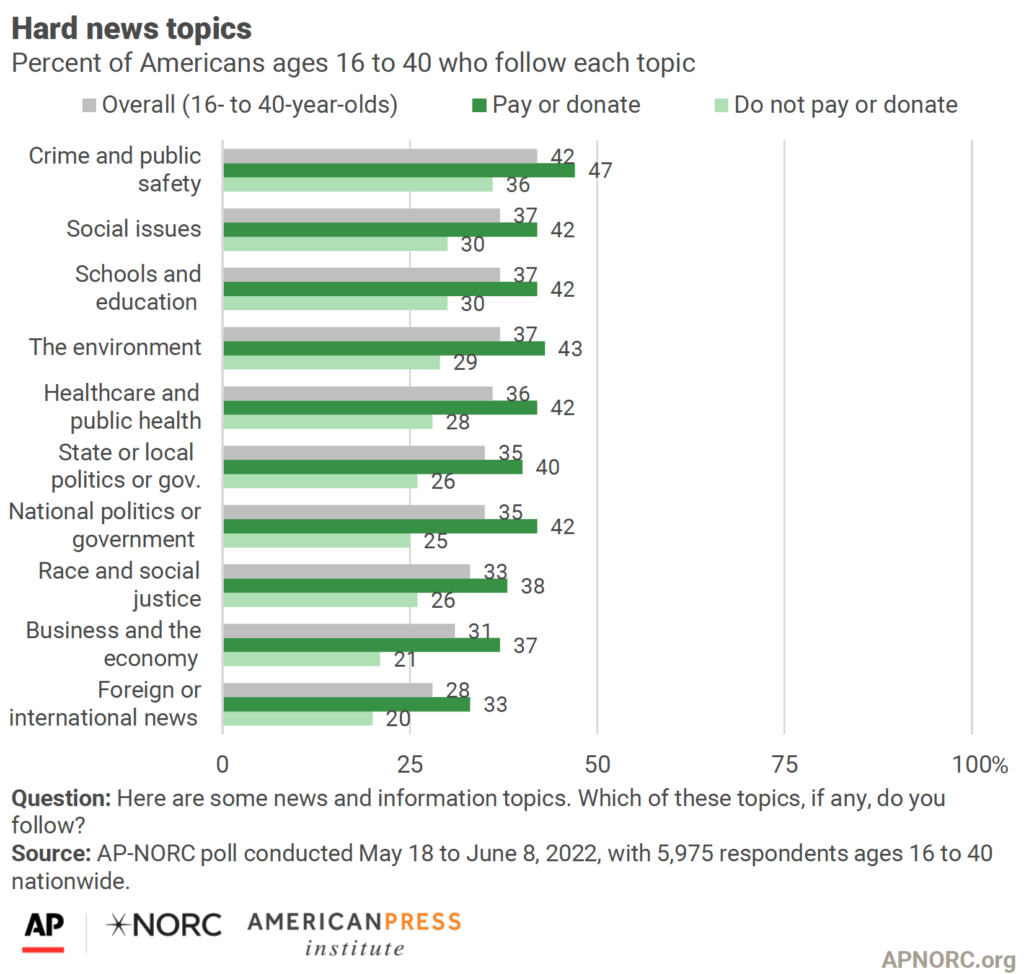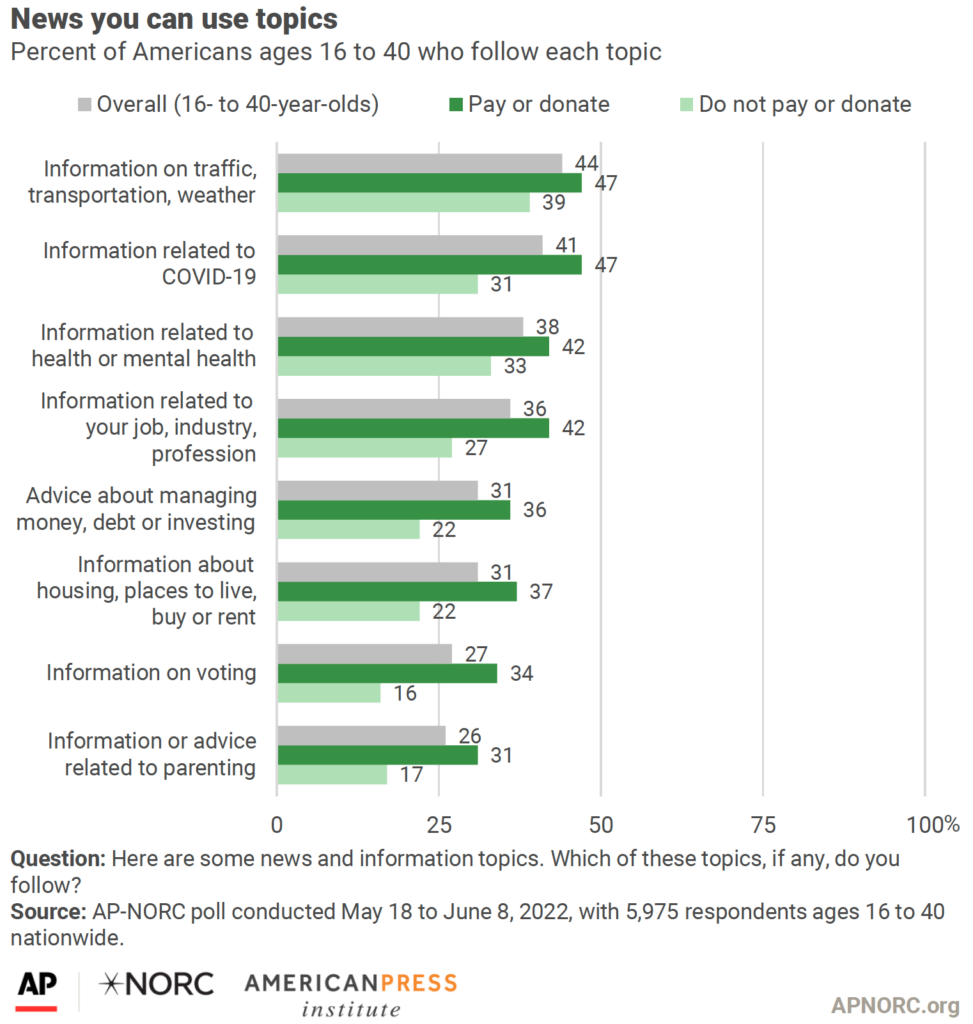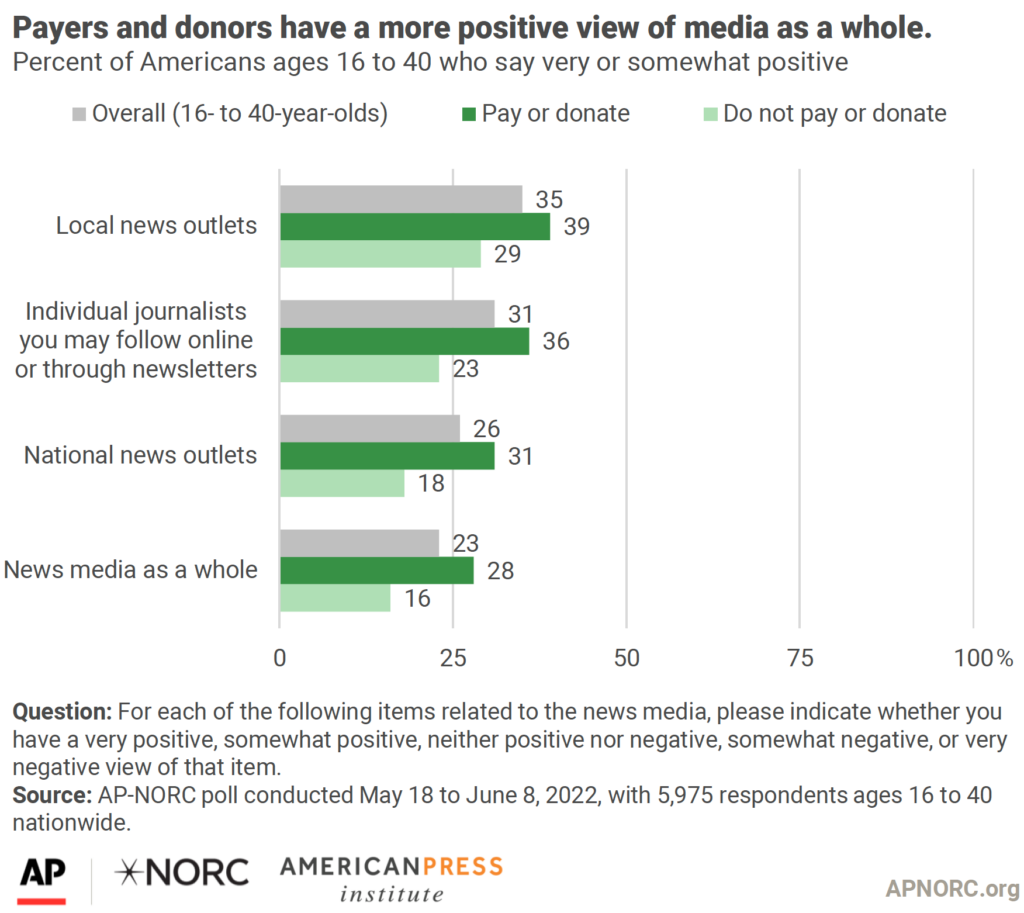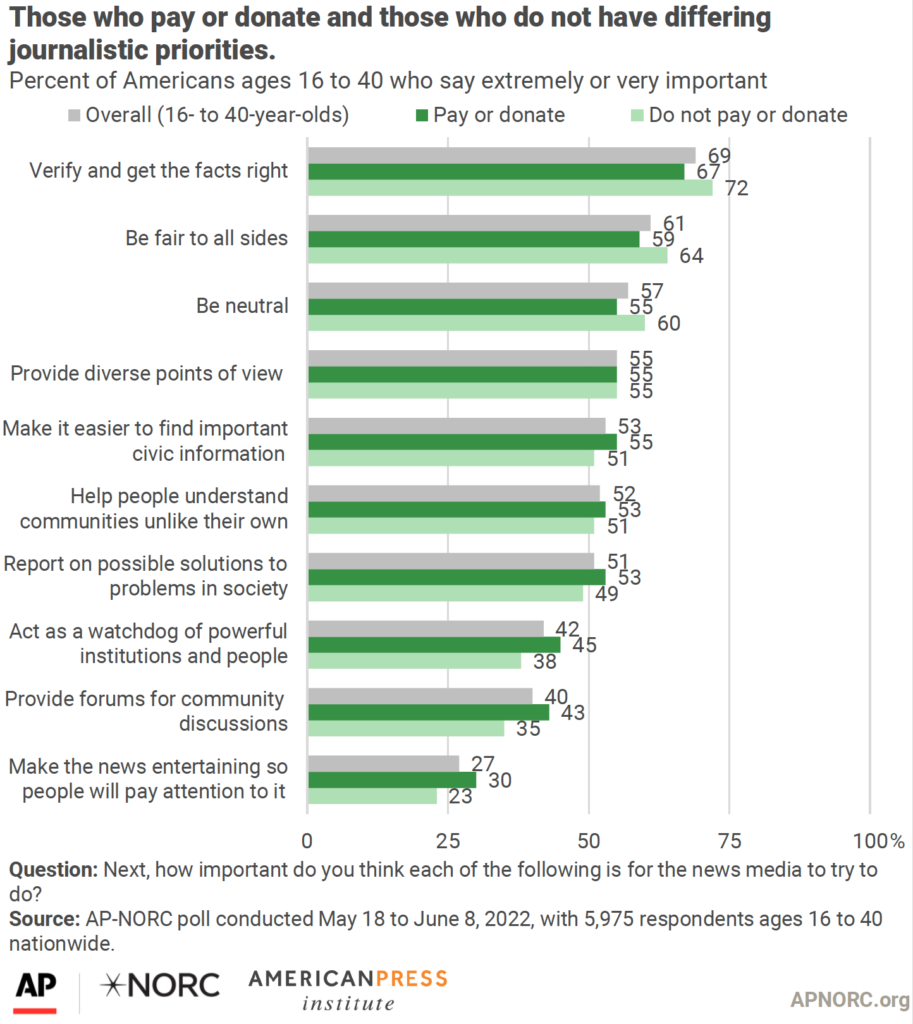Americans have a wide range of options for paying for or donating to news today. There are legacy sources, start-up news organizations, and independent creators, and at times more than one way to pay for or donate to each. This study finds that 60% of Americans ages 16 to 40 pay for or donate to news in some fashion. [ref This report expands upon brief findings on paying for or donating to news from our first report, “Fatigue, traditionalism, and engagement: news habits and attitudes of the Gen Z and Millennial generations.” That report noted 45% of Gen Z and Millennials either pay for traditional or legacy news products (like newspapers, magazines, or news apps) or donate to other often donation-focused sources (nonprofit news sites, email newsletters from independent creators, video or audio content from independent creators or influencers through YouTube or podcasts, public radio, or TV, or other apps). Here we evaluate the 60% who either pay for or donate to any of the news sources we evaluated, allowing analysis of those who, for example, donate to a newspaper or pay for an email subscription from an independent creator. This wider definition is intended to allow analysis of the broad base of Gen Z and Millennials who pay or donate, the lines which increasingly are blurred.]
Overall, 16- to 40-year-olds who pay for or donate to news skew a bit older, even within this subgroup of Americans. Gen Z makes up 29% of the payers or donors vs. 42% of the non-payers or non-donors, while older Millennials make up 42% of those who pay for or donate to news and 32% of those who do not pay for or donate to any.
However, it is important to note that paying for or donating to news isn’t rare even among this youngest generation of news consumers. Among all of Gen Z, about half of them report paying for or donating to some type of news content.
The tendency to pay for or donate to news also cuts across all major ethnic and racial categories. Indeed, a majority of Gen Z and Millennials regardless of race or ethnicity pay for or donate to some type of news, including 68% of Black Americans, 63% of Hispanic Americans, 60% of Asian Americans, and 57% of white Americans ages 16 to 40.
Gen Z and Millennials who pay for or donate to news are more likely to live in urban neighborhoods rather than rural communities. Yet about 1 in 5 payers or donors live in rural communities.
Do Millennials and Gen Z who pay for or donate to news act differently online than their peers who don’t?
The answer is broadly yes.
The study measures various news behaviors. One is how much time people spend online. Another metric tracks what they do online. A third metric tracks a characteristic the Media Insight Project developed in 2015 — whether someone self-identifies as being a person more likely to bump into the news or to actively seek it. We call this the “bumper” vs. “seeker” metric.
People who pay for or donate to news are more likely to register highly on all three of these metrics. They are more likely to be online more often, they perform more activities online, and they are more likely to be seekers than those who don’t pay for or donate to news.
First, those in the Gen Z and Millennial generations who pay for or donate to news spend more time online and connected daily. Twenty-seven percent say they spend 9 hours or more online compared to 19% of those who do not pay for or donate to any news source.
While almost all Gen Z and Millennials are online much of the time and perform many activities there, those who pay for or donate to news stand apart from those who don’t. We asked about a range of different actions people take online. Gen Z and Millennials who pay or donate do some things at similar rates as those who don’t — such as sending/checking email or messages, keeping up with friends or family, and other recreational activities like streaming audio or video.
However, those who pay for or donate to news are more likely to do some other activities — namely, keeping up with what is going on in the world, researching topics they are interested in, checking the weather or traffic, finding information about things to do, listening to podcasts, or watching videos.
Our measure of bumping into and seeking the news adds to these differences. Further, it suggests that the future of news requires news organizations to find consumers who bump into the news instead of waiting for those consumers to find them.
Gen Z and Millennials who pay for or donate to news are more likely to seek out news than their peers who do not pay for or donate to news. Yet, Gen Z and Millennials who pay or donate are still more likely to bump into news than to seek it (54% bump vs. 45% seek).
This is particularly important for journalists, news organizations, and independent news creators since they need a robust online and social media strategy to ensure their content or cause is getting in front of their paying customers. They will also need an even more ambitious or targeted strategy to attract those who do not pay for or donate to news.
Another important indicator of whether a consumer is more likely to be a paying or donating customer is how often they get news. Gen Z and Millennials who pay for or donate to news are more likely to get news and information at least daily from traditional media sources (56% vs. 28%) such as national and local news outlets, newspapers, and TV than those who do not pay or donate.
However, the gap between those who pay or donate and those who do not shrinks when it comes to getting news from social media platforms (77% vs. 62%). Again, these differences show how journalists and publishers from traditional sources may find it harder to attract the younger audiences without being active in the right social media platforms and highlighting the topics and conversations they gravitate to. [ref The second report in our series, “Knowing the news: How Gen Z and Millennials get information on essential topics,” analyzes how Gen Z and Millennials follow and interact with key “hard news” and “news you can use” topics.]
Those who pay for or donate to news are about twice as likely than those who do not to engage with news in a number of ways: either by texting, sharing, or talking about it with family or friends or by commenting on social media or news organizations’ websites at least daily.
Overall, more Gen Z and Millennials who pay for or donate to news get news from social media platforms at least daily than those who do not pay for or donate to news. On average, those who pay for or donate to news get news from two social media platforms at least daily while those who do not pay for or donate to news get news from only one.
Facebook, YouTube, and Instagram are the most-used platforms for both groups.
Twitter has one of the biggest gaps between Gen Z and Millennials who pay for or donate to news and those who don’t. [ref The poll was conducted May 18 to June 8, 2022, months before Elon Musk acquired Twitter in October 2022, laid off thousands of employees and began sweeping changes to the platform. https://apnews.com/article/elon-musk-twitter-inc-technology-business-san-francisco-ee1e283ff873813524ff21b0a7751b47]Those who pay for or donate to news are twice as likely to get news and information from this platform than those who do not pay for or donate to news.
Also, payers or donors use Nextdoor, Reddit, LinkedIn, or Twitch more than non-payers or non-donors, suggesting they use a variety of platforms to get news and information while those who do not pay or donate tend to focus on fewer social media sources for it.
What topics do Millennials and Gen Z who pay for or donate to news follow compared to their peers who don’t?
Another key way we explore the news behavior of Americans ages 16 to 40 is by probing what topics they follow or pay attention to. Our survey asked people if they follow news across a wide range of topics. For our analysis, we then grouped those topics into three broad categories such as “lifestyle,” “hard news,” and “news you can use.”
What we found is that people who are more likely to pay for or donate to news tend to be larger consumers of news across all these categories. Indeed, on nearly every topic — though less so for a few — payers or donors follow them regularly more often than non-payers and non-donors.
However, the topics they follow most often are not necessarily the same between payers or donors and those who do not pay for or donate to news. This is important for news media and creators since it shows how certain topics are key to keeping payers and donors engaged, while others may be good to reach potential payers and donors.
The following tables break down the details for each topic. The first table lists “lifestyle” topics. And as you can see, those who don’t pay or donate are not more likely than those who do pay or donate to follow any of the topics.
The second table tracks consumption of “hard news” topics including politics, government, public health, race and social justice, education, and the environment. Here, too, payers or donors are more likely to follow these topics — often by even higher margins than for “lifestyle” topics.
The last table tracks what many journalists call “news you can use” topics. These are ones that provide people with information that is directly actionable. What do I need to know about the latest on COVID, or health services, how to vote, traffic and weather, and more?
Here, too, while these topics are generally applicable to many people, those who pay for or donate to news are more likely to follow them.
The most-followed topics, however, vary across those who pay for or donate to news and those who do not.
For Gen Z and Millennials who pay for or donate to news, the topics they most often follow are:
- Information about COVID-19
- News about celebrities, music, or TV
- Sports
- News about national politics or government
- Information on traffic, transportation, or weather
For those who do not pay for or donate to news they topics they most often follow are:
- Information on traffic, transportation, or weather
- News about celebrities, music, or TV
- Sports
- News about social issues such as abortion, gun policy, and LGBTQ issues
- Information related to health or mental health
What do Gen Z and Millennials see on social media, and how do they react to it?
Gen Z and Millennials who pay for or donate to news see a similar range of opinions as those who do not. But payers and donors say they are more likely to click or investigate opinions that are different from their own than non-payers or non-donors are.
Payers or donors are also more aware of how products may manipulate them online. For instance, those who pay for or donate to news are more likely than those who do not to pay attention to the way certain products keep them engaged and connected. They are also more likely to use apps to track how much time they spend connected and online.
Both groups, however, are equally likely to set limits on the amount of time they spend on their phone or computer and to feel worse the longer they spend connected and online. In other words, it does not seem like digital fatigue is a primary driver of why some Gen Z and Millennials are not paying for or donating to news even when considering that Gen Z and Millennials who pay or donate use social media more frequently.
What about attitudes toward the media? Do those views correlate in any way with whether someone might be likely to pay for or donate to news?
The study suggests the answer is yes.
Those who pay for or donate to news have a more positive view of national news, local news outlets, and news media as a whole and individual journalists than those who do not pay for or donate to news and Americans ages 16 to 40 overall. It is relevant to note that local news outlets and individual journalists are viewed the most positively among the types of media asked in the survey.
What do Americans ages 16 to 40 want the news media to do? What do they consider journalistic priorities?
We tried to track a variety of metrics here, and the findings are less predictable than expected. In general, both those who pay for or donate to news and those who do not rank what they consider should be the media’s priorities in the same order.
But sometimes non-payers or donors put an even higher value on some of these priorities than those who do pay for or donate for news. For instance, 67% of payers or donors want the press to get the facts right. But the number is 72% among non-payers or non-donors. Fully 59% of payers or donors want the press to be fair to all sides. The number is even higher, 64%, among non-payers or non-donors. And 55% of payers and donors want the press to be neutral. But that number rises to 60% among non-payers or non-donors.
Those who pay for or donate to news are more likely to consider acting as a watchdog of powerful institutions, making the news entertaining, and providing forums for community discussions as priorities for the media than those who do not pay for or donate to news.
Continue reading: Gen Z and Millennials who pay for or donate to print or digital newspapers
Share with your network
Funding news: How Gen Z and millenials pay for or donate to news
You also might be interested in:
As research continues to inform this slice of the news industry, we’ll continue learning, too. Who gets to be called a journalist in 2025 and beyond? What is the future of trustworthy information, especially considering the access to and trust for online content creators? How might journalism adapt to the rise, or co-opt the styles, of news influencers?
What if we started looking at our output as a product, not a service? Too often, we think "product" means a fancy app or a new website. But product isn’t about tech. It’s about intention.
When we began asking what kind of stories still mattered to Baca County, we realized many of them weren’t “breaking news” but generational memory. And the paper was the last remaining platform that treated those memories with care and context.

